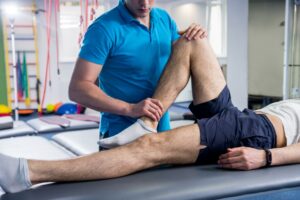The Role of Physical Therapists in the Healthcare Field
The more experienced I get in the field, the more I realize I do a very poor job of explaining a simple question: What exactly is a physical therapist and what exactly do they do? Seems like a simple answer, but as I have found over the last 3 years, the majority of the population has no experience with physical therapists. I have heard the saying of PT being referred to as “pain and torture.” And in some cases, this assumption can be correct.
Did you know if you’re being exhausted by exercise in a session that is usually a good thing? That your pain has been controlled, you are gaining functional mobility, and your therapist feels you are ready and able to perform complex activities? This is NOT for our personal enjoyment. The purpose of this blog is to provide some background into what exactly a physical therapist does. We always try to provide a good experience, and I feel it is important to set expectations for your first visit and beyond.

Did you know, for the majority of insurance companies, a referral or visit to your primary care provider is NOT required to begin physical therapy? This is one of the most common misconceptions in the healthcare field and has become a major barrier to getting the care you need in a timely manner.
Physical Therapy is a branch of the healthcare profession focused on optimizing movement, daily function, and quality of life for individuals of all ages. The main role of a physical therapist in the healthcare profession is to rehabilitate previous injuries and return the ailing individual to full prior function. However, PTs also play a crucial role in injury prevention and health promotion to build a solid foundation for a pain-free lifestyle. PTs use a diverse skillset to diagnose and treat conditions of the musculoskeletal, neurological, cardiopulmonary, and integumentary systems.
Assessment and Evaluation:
On your first day of physical therapy, a comprehensive evaluation and assessment will be performed to identify impairments, functional limitations, and participation restrictions. This will be done through a series of discussions of medical/symptom history, objective measurements (range of motion, strength, etc.), assessment of measurements, education of findings, and development of goals. This detailed process allows the ability to develop a proper, personalized plan of care tailored to each patient’s specific needs.
Treatment Planning and Implementation:
Collaboration is important after the evaluation and assessment have been completed. An open discussion will be had between patient/therapist to set expectations, determine specific goals, and establish optimal outcomes. Education will be provided regarding specific exercises and areas to target for improvement. Treatment interventions may include:
- Manual Therapy: Hands-on techniques such as joint mobilization, soft tissue mobilization, and manual stretching to improve joint mobility, reduce pain, and enhance tissue flexibility.
- Therapeutic Exercise: Customized exercise programs focusing on strength, flexibility, endurance, balance, and coordination to improve functional capacity and promote recovery.
- Gait and Mobility Training: Training individuals to improve walking patterns, mobility skills, and functional movement patterns using assistive devices or gait aids as needed.
- Patient Education: Providing education on injury prevention, self-management strategies, ergonomic principles, and home exercise programs to empower patients to take an active role in their recovery and long-term health.
Rehabilitation and Recovery:
Physical therapists work closely with patients throughout the rehabilitation process, monitoring progress, adjusting treatment plans as needed, and providing ongoing support and encouragement. Whether recovering from surgery, managing a chronic condition, or rehabilitating from an injury, the ultimate goal is to optimize outcomes and facilitate a smooth transition back to daily activities and functional independence.
Prevention and Wellness Promotion:
In addition to the rehabilitation of a specific injury, PTs are actively involved in promoting a healthy lifestyle, wellness, and injury prevention. This will be included in most or all sessions through education and empowerment of individuals to adopt healthy lifestyle habits, improve movement capabilities, and reduce the risk of injury or disability.
Your Physical Therapist:
Physical therapists play a vital role and are a huge component of the healthcare team along your road to recovery. More often than not, your physical therapist will be the practitioner you see the most of throughout the process. Through compassion and commitment to your overall well-being, PTs guide you in the recovery process of assessment and treatment to rehabilitation and wellness promotion. Our end goal is to establish a process-oriented regimen to continue down a healthy, active lifestyle into the future.
If you are experiencing aches, pains, or an overall decrease in daily activities, we would be happy to help! My name is Alec Hoffman DPT and I am the only practicing physical therapist here, so you do not have to worry about juggling between different physical therapists throughout your plan of care. However, we have multiple clinical personnel with different areas of expertise at Ashworth Clinic who are all happy to help based on your specific needs. If you are dealing with aches, pains, or a general loss of functional capabilities, please reach out at 515-225-4002 or you can schedule an appointment online.


